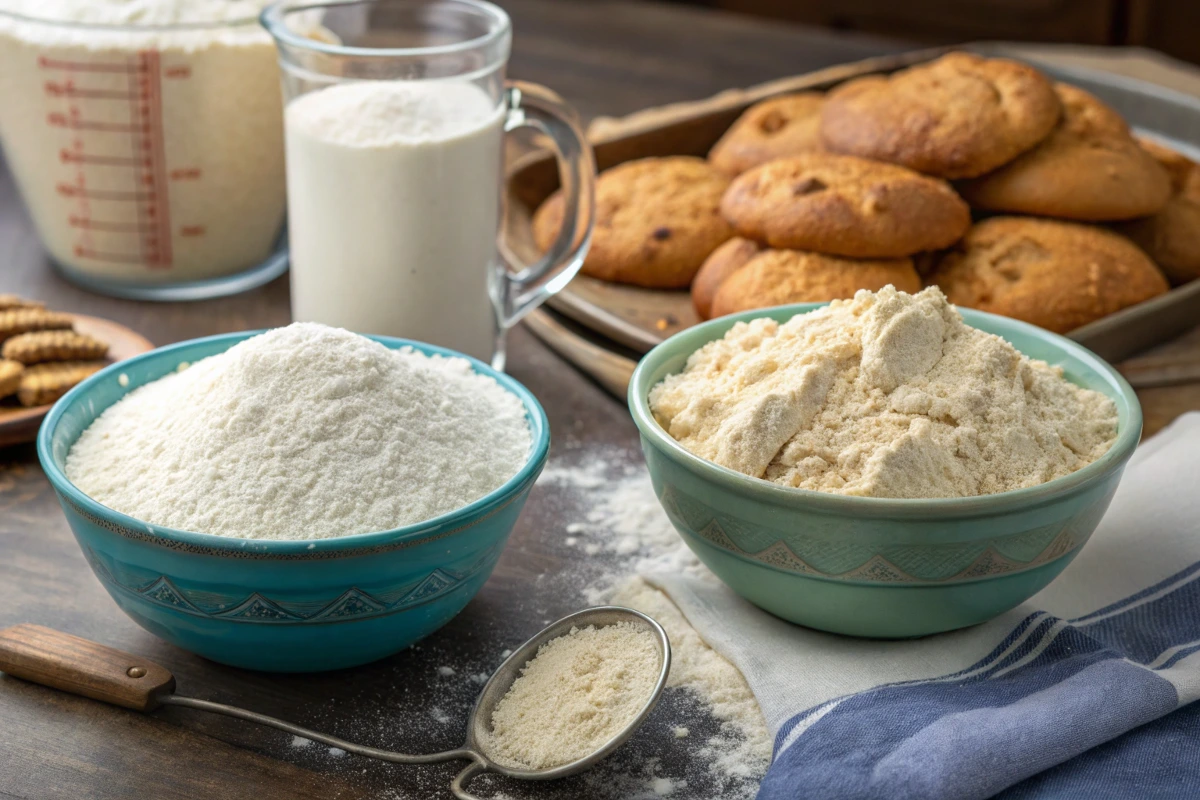Baking is both an art and a science, and choosing the right flour can make or break your masterpiece. While many recipes call for bread flour or all-purpose flour, knowing the differences between the two can elevate your baking game. In this article, we’ll explore the unique properties of these flours, their practical uses, and how to substitute one for the other effectively. Whether you’re a seasoned baker or just starting out, understanding the nuances of these flours will help you craft the perfect baked goods.
Overview of Bread Flour and All-Purpose Flour
What is Bread Flour?
Bread flour is the powerhouse of flours, boasting a higher protein content compared to other varieties. Typically ranging from 12% to 14%, this flour is milled from hard wheat, which is known for its strength. The high protein levels in bread flour enable it to develop more gluten, resulting in baked goods that are chewy, structured, and elastic.
Commonly used for making yeast breads, pizza crusts, and bagels, bread flour provides the robustness needed to create those signature airy textures and crisp crusts. For anyone aiming to master bread baking, this flour is a go-to choice.
What is All-Purpose Flour?
as the name suggests, is the jack-of-all-trades in the baking world. Made from a blend of hard and soft wheat, it strikes a balance with a protein content of 10% to 12%. This versatility allows it to work in a variety of recipes, from cookies and cakes to muffins and pancakes.
While it may not provide the same chewiness or structure as bread flour, all-purpose flour offers more flexibility. It’s an ideal option for bakers who want a universal flour that performs well across the board.
Key Differences Between Bread Flour and All-Purpose Flour
Protein Content: The Key Distinction
The biggest difference between bread flour and all-purpose flour lies in their protein content. Bread flour has a protein level of about 12% to 14%, while all-purpose-flour ranges between 10% and 12%. This protein disparity directly impacts how much gluten is formed when the flour is mixed with water.
Gluten acts like a stretchy net, trapping air and giving structure to your dough. That’s why bread flour is ideal for recipes requiring a strong, chewy texture, like artisan breads and bagels. In contrast, all-purpose flour produces softer, more tender baked goods like cookies or muffins. If you’ve ever wondered what the difference between bread flour and all purpose flour is, this protein variation is at the heart of it.
Gluten Formation and Structure
Thanks to its higher protein content, bread flour produces more gluten, giving doughs better elasticity and strength. This extra gluten is why bread dough can rise higher and hold its shape during baking. All-purpose flour, with less gluten, results in lighter and softer textures. While this makes it versatile, it’s not always the best choice for recipes where structure and chewiness are essential.
For example, a pizza crust made with all-purpose flour might tear more easily and lack that satisfying chew. But, if you’re baking a tender cake or flaky pie crust, the lower gluten levels of all-purpose flour are your friend.
Moisture Absorption Levels
Another important difference is how these flours handle hydration. Bread flour absorbs more water due to its higher protein content. This characteristic is key in recipes like sourdough or focaccia, where wet doughs yield airy and tender results. All-purpose flour, on the other hand, absorbs less water, making it better suited for quick breads and cakes that don’t require lengthy hydration periods.
Practical Applications in Baking
Best Uses for Bread Flour
Bread flour shines in recipes that demand strength and structure. It’s a baker’s best friend for crafting chewy, airy baked goods. Use it for:
- Yeast breads, like sourdough, whole wheat, and sandwich loaves.
- Bagels and pretzels that need a firm texture and dense chew.
- Pizza dough, where elasticity is crucial for that crispy crust and airy crumb.
For novice bakers or anyone focusing on bread recipes, bread flour is the way to go.
Best Uses for All-Purpose Flour
the versatile champion of the kitchen. It works well in recipes that require a balanced texture—neither too dense nor too airy. It’s great for:
- Cookies, where softness and tenderness are key.
- Muffins and quick breads, which don’t rely on heavy gluten formation.
- Cakes and pastries, where a finer crumb and delicate structure are desired.

Substituting One for the Other
Can You Use All-Purpose Flour Instead of Bread Flour?
instead of bread flour, but results may vary depending on the recipe. Because all-purpose flour has a lower protein content, the baked goods will likely be softer and less chewy. For example, in bread recipes, substituting might lead to a loaf with less structure and elasticity. However, adding vital wheat gluten to all-purpose flour can help mimic the properties of bread flour.
When baking cakes, muffins, or cookies, instead of bread flour is often acceptable. The lighter texture of all-purpose flour might even work better for these recipes. Keep in mind, though, that subtle differences in texture and rise may occur.
When Substitution is Not Ideal
Substitution is not always a good idea, especially for recipes that heavily rely on gluten formation, like sourdough, bagels, or pizza dough. Using all-purpose flour in these recipes can result in dough that tears easily or doesn’t achieve the desired chewiness.
If bread flour is unavailable, consider trying recipes that don’t require such strong gluten development. For example, check out this savory bread pudding recipe for a delicious option that makes the most of softer flours.
Health and Nutritional Aspects
Nutritional Differences Between Bread Flour and All-Purpose Flour
When comparing what the difference between bread flour is nutritionally, the protein content is a standout factor. Bread flour, with its higher protein levels, typically contains more calories per cup than all-purpose flour. For example, a cup of bread flour provides around 120 calories and 4 grams of protein, while the same amount of offers slightly fewer calories and about 3 grams of protein.
Both flours are often enriched with vitamins and minerals, like iron and B vitamins, to support a balanced diet. However, the choice between them depends more on your baking goals than on nutritional differences.
Health Implications of Higher Gluten Content
For individuals with gluten sensitivity or celiac disease, the higher gluten content in bread flour may pose a challenge. Gluten provides the elasticity and chewiness in baked goods, but it can also trigger adverse reactions for those with gluten intolerance. For such cases, gluten-free alternatives are a safer choice.
For more tips on working with flour alternatives or gluten-free recipes, browse the helpful resources available on MrsRecipesChef.com.
Common Questions About Bread Flour and All-Purpose Flour
What Happens If You Use All-Purpose Flour Instead of Bread Flour?
One of the most common questions is whether all-purpose flour can replace bread flour. The short answer is yes, but there will be differences in texture and rise. For instance, bread made with all-purpose flour will have a softer crust and less chew. If you’re in a pinch, the substitution works, but the result won’t replicate the structure and elasticity of bread flour-based recipes.
Can Bread Flour Be Used for Cakes?
While it’s technically possible to use bread flour for cakes, it’s not ideal. Bread flour’s high protein content creates more gluten, resulting in a dense and chewy texture traits better suited for bread than cakes. Cakes made with bread flour may lack the softness and fine crumb achieved
How Do You Make Bread Flour from All-Purpose Flour?
If you find yourself out of bread flour, you can create a substitute by adding vital wheat gluten to all-purpose flour. Simply mix 1 teaspoon of vital wheat gluten per cup of all-purpose flour. This adjustment increases the protein content and improves gluten development, making it a closer match to bread flour.
Is Bread Flour Healthier Than All-Purpose Flour?
offer similar nutritional profiles, but bread flour contains slightly more protein. For those focusing on protein intake, bread flour might be a better choice. However, for most people, the difference in health benefits is negligible and depends more on the type of baked goods you’re consuming.
Tips for Choosing the Right Flour
Factors to Consider When Selecting Flour
When deciding between bread flour and all-purpose flour, start by considering the recipe. Recipes requiring a strong dough structure—like pizza, sourdough, or bagels—will benefit from the high protein content in bread flour. On the other hand, for cookies, cakes, or pancakes, is versatile and provides a lighter texture.
Another factor to consider is your desired outcome. Do you prefer a chewy crust and airy crumb, or something tender and soft? Choosing the right flour aligns your baking with your expectations, ensuring you achieve the best results.
FAQs from “People Also Ask” Section
What is the Main Difference Between Bread Flour and All-Purpose Flour?
The primary difference lies in their protein content. Bread flour contains 12–14% protein, while all-purpose has around 10–12%. This difference impacts gluten formation, making bread flour ideal for chewy and structured baked goods, and all-purpose flour better for soft, tender treats.
Can You Use Bread Flour Instead of All-Purpose Flour?
Yes, but the results may vary. Using bread flour in recipes designed for all-purpose can result in a denser texture due to its higher protein content. For example, cookies made with bread flour might turn out chewier than intended. For cakes or pastries, bread flour’s extra gluten might produce an overly tough result.
How Do I Store Bread Flour and All-Purpose Flour?
Both types of flour should be stored in a cool, dry place, ideally in an airtight container. This prevents moisture and pests from ruining your flour. For long-term storage, especially for bread flour, you can refrigerate or freeze it to extend its shelf life.
Are There Health Benefits to Using Bread Flour Over All-Purpose Flour?
If you’re looking to increase your protein intake slightly, bread flour is a good choice. However, the nutritional differences are minor. The decision often comes down to the texture and structure required for your recipe rather than significant health benefits.
Final Tips for Flour Success
Practical Advice for Home Bakers
always start with your recipe. It’s easier to follow the specific type recommended to ensure the desired texture. If substitutions are necessary, be mindful of how they might change the result. Adding vital wheat gluten to all-purpose can help mimic bread flour’s characteristics.
Experimenting with Recipes to Learn the Differences
One of the best ways to understand what the difference between bread flour and all purpose truly means is through hands-on experimentation. Try baking the same recipe with both flours to observe differences in texture, flavor, and structure. For instance, make a loaf of bread with each type and compare the chewiness and rise.
For more recipe inspiration, consider exploring savory or sweet baked goods that suit your chosen flour. This approach not only improves your baking but also helps you decide which flour to stock in your pantry for future projects.

